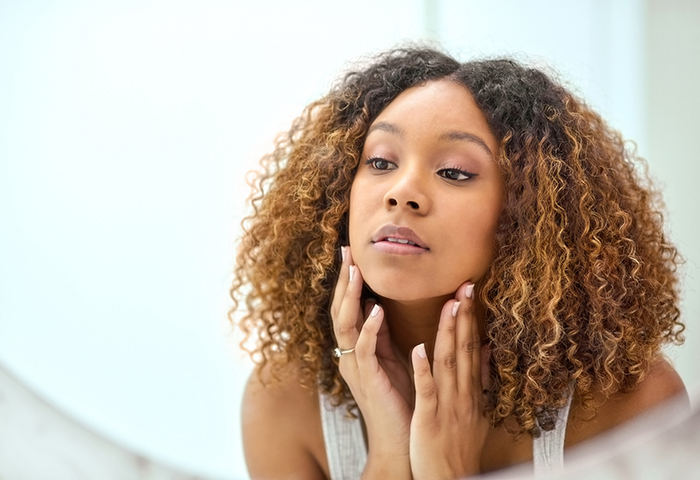We all know the glorious feeling that comes with waking up and finding that a pesky pimple has finally vanished after days (or even weeks”> of frustration and pain. However, even when your skin is smooth again, sometimes a red or brown mark remains. I like to call them pimple ghosts, but they are actually post-inflammatory hyperpigmentation. These marks often last much longer than zits, and they can be pretty stubborn. Hyperpigmentation can also be a result of sun damage. Whatever the cause, there are a few important ingredients to look for when choosing skincare products that can speed up the healing process and keep you looking like the glowy goddess you are.

Image by iStock/PeopleImages
1. Sunscreen
Sunscreen is the most essential part of your skincare routine, and it’s especially important for treating hyperpigmentation. Even if you’re using the very best products on your skin, they are useless without sunscreen because of the damage the sun can do to our skin. Sunscreen protects hyperpigmentation marks, allows them to heal, and also prevents new sun damage.
There are two main types of sunscreen — chemical and physical. Physical sunscreens are made with zinc oxide and titanium dioxide, and they sit on your skin and physically block the sun’s rays. I know you’re probably picturing a dorky dad on vacation with a thick layer of zinc oxide on his nose, but there are plenty of physical sunscreens formulated so that they don’t leave a white cast on your skin, even for dark skin tones. Chemical sunscreen is made with ingredients like avobenzone, oxybenzone, octinoxate, and octisalate, which absorb the sun’s rays and break them down so they don’t harm your skin.
There are lots of daily sunscreens out on the market. When choosing a sun protection product, make sure you get one that offers protection from both UVA and UVB rays and that it is SPF 30 or higher. It is also important that you apply enough sunscreen (usually about 1/4 teaspoon for your face”> and that you are re-apply often enough (check your sunscreen for re-application guidelines”>. Sunscreen is serious business, y’all.
2. Vitamin C
Vitamin C is a powerful antioxidant, which means it evens skin tone by lightening those pesky dark spots. This ingredient is most commonly found in the form of a vitamin C serum, which is used before your moisturizer. There are also moisturizers that have vitamin C as a key ingredient. Most products that contain vitamin C say so on the front of the package. However, if you want to check a product to see if it has vitamin C, it will probably be listed under the ingredients as ascorbic acid or L-ascorbic acid.
3. Niacinamide
Niacinamide is a great ingredient to start with because it’s available in a wide variety of product types—cleansers, toners, serums, and moisturizers. Just like all the ingredients I’ve included in this list, niacinamide is clinically proven to help fade hyperpigmentation, no matter the cause. It is also an incredible skin hydrator, so it’ll help keep your skin plump and healthy. Additionally, it aids in skin cell production, which is essential to fading the look of brown spots.
4. Beta-hydroxy acid
Chemical exfoliation is actually gentler than physical scrub exfoliants, despite how scary the thought of putting acid on your skin may sound. There are many types of acids, and they are wonderful for evening skin tone and fading hyperpigmentation. For hyperpigmentation caused by pimples, one of the best is beta-hydroxy acid—aka BHA. It often comes in the form of salicylic acid, and it’s great for acne-prone or oily skin. It can penetrate pores to slough off dead skin and pore-clogging oil, which has the added effect of making pores appear smaller while evening your skin tone and lightening dark spots.
5. Alpha-hydroxy acid
This is another chemical exfoliant, and you may know it by its most common forms, glycolic acid and lactic acid. AHAs work on the surface of the skin, and they have been proven to help reduce the visible signs of sun damage, such as sun spots. As with all acids, just make sure you follow the package instructions for how often to use them — some are safe for daily use, while some should only be used weekly. The chemical exfoliants often come in the form of a standalone product, but there are also serums and moisturizers that contain them as ingredients. Just make sure you’re using them in a product that will stay on your skin — they don’t have enough time to work if you’re only using them in a cleanser.

6. Azelaic acid
This acid is newer to the mainstream skincare game, but it is getting a lot of hype for its many skin benefits. One of those benefits is reducing the appearance of post-acne hyperpigmentation, along with helping reduce current breakouts. Even better, this acid is incredibly gentle, so even those with sensitive skin can use it. In fact, it can help reduce skin sensitivity. It also helps unclog pores and treat and prevent bumpy skin. Since this ingredient isn’t currently used by a lot of skincare companies (the research on its benefits is fairly recent”>, it’s not as widely available as other exfoliants. However, there are a few companies, such as The Ordinary and Paula’s Choice, that make azelaic acid serums.
Another benefit of azelaic acid is that it is gentle enough that you can pair it with a mild AHA or BHA, so your skin gets the benefits from multiple kinds of exfoliation. One thing to keep in mind is that exfoliants make your skin more sensitive to the sun. No matter how gentle the acid, you absolutely must wear sunscreen over it if you’re wearing it during the daytime (but you’re already wearing sunscreen every day, right?”>.
7. Retinol
Retinol (aka vitamin A”> is most commonly known for its ability to make skin look younger and reduce the appearance of wrinkles. However, this ingredient is also very good at evening skin tone and brightening dull skin, so it’s a great option for treating hyperpigmentation (especially hyperpigmentation caused by sun damage”>. On top of that, it also helps clear breakouts and makes pores appear smaller. It’s basically the Swiss army knife of skincare.
Before you go bathing yourself in retinol, make sure you know how to use it properly. Start with making sure you’re using the right concentration for your skin. Retinol can be found as an ingredient in both serums and moisturizers. If you have sensitive skin, look for a retinol product with a low concentration. A high concentration of retinol is 1%, so products with around 0.01% – 0.03% retinol are best for sensitive skin. Those concentrations may sound like nothing, but studies have shown that retinol is still effective in those small doses.
When starting a new retinol product, make sure you start gradually—only using it once or twice a week—and work your way up. This rule is applicable even for those without particularly sensitive skin. Listen to your skin; make sure you stop using it immediately if you notice excessive dryness, peeling, or redness. You can still reap the benefits of retinol even if you aren’t able to use it every day. Like exfoliants, retinol can make your skin sensitive to the sun, so always follow it up with sunscreen if you’re using it in your morning routine.
8. Hydroquinone
This ingredient is controversial because it treats hyperpigmentation by stopping melanin production. It was also banned by the FDA for a short time, but that was due to improperly formulated products containing illegal contaminants having adverse effects in South Africa.
Hydroquinone is safe to use, and it’s very effective for hyperpigmentation. It can be found in specialty spot treatment gels or creams, and that’s how they should be used—only on hyperpigmentation spots. Some call it a skin-bleaching ingredient, but that’s a bit of a misnomer.
It does not bleach out the color that exists; rather, it prohibits the skin from darkening any further. Because it prevents skin from getting darker, it works very well for treating hyperpigmentation. There are people who may want to use it all over their skin for an overall lightening of the skin tone, but that is not its intended use. Beyond that, every skin tone is beautiful, and no one should feel that they need to lighten their skin. Hydroquinone should be used as a spot treatment to even skin tone, not lighten skin.
9. Time
This one can be frustrating to hear, but even when using products with these hardworking ingredients, your hyperpigmentation marks will only fade with time. When using good products, I have had some fade as fast as two weeks, but it can take 3+ months for some marks to fade.
These ingredients are all fantastic for lightening those spots, and giving you a gorgeous glow. However, don’t use them all at once—that can be way too harsh. Introduce each ingredient one at a time, and give your skin a week or two to adjust before using new products. Use some in the morning, some in the evening, or you may need to only use some a couple of times per week. The most important thing is to listen to your skin — if you slowly work these into your routine, it will definitely say, “thank you!”
Do you have a favorite product for treating hyperpigmentation? Give it a shout-out in the comments! And if you’re looking for new product recommendations, check out our Editor’s Choice 2018 Best Skincare picks!
